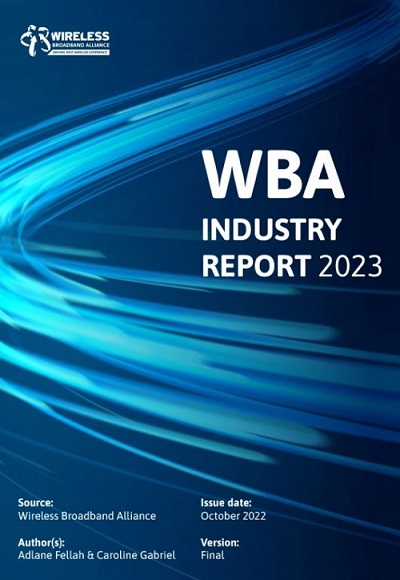Wi-Fi 7 is emerging as one of the most important areas of investment in new connectivity technologies. That is a key finding from the latest cross-industry survey of service providers, technology vendors and enterprises by the Wireless Broadband Alliance (WBA), the global industry body dedicated to improving Wi-Fi standards and services.
The findings, released by the WBA as part of the WBA Annual Industry Report 2023, reveal more than a third of service providers, technology vendors and enterprises already have plans to deploy Wi-Fi 7 by the end of 2023. Wi-Fi 7 will supercharge Wi-Fi capabilities with new technologies, such as multilink operation and time sensitive networking – ideal for Industry 4.0 applications – while leveraging the 6GHz spectrum dynamically with automatic frequency coordination.
The report also revealed that Wi-Fi 6E has now become the de facto industry standard, with 53 percent having deployed it and a further 44 percent working on plans to adopt Wi-Fi 6E in the next 12-18 months.
Uptake of Wi-Fi 6E and Wi-Fi 7 is being driven by a growing appetite for data-intensive, low-latency applications and use cases, from smart cities and immersive technologies such as the future metaverse to Industry 4.0. Newer Wi-Fi technologies offer better scheduling and greater interference management, which respondents to the survey now see as essential in supporting high-quality video, virtual reality (VR), augmented reality (AR) and other advanced consumer experiences.
The report detailed a renewed focus on the quality of experience (QoE) delivered to end-users, with 90 percent of service providers, equipment manufacturers and enterprises ranking it as a key differentiator in monetizing their Wi-Fi services. Sixty-one percent of respondents identified services such as high-definition video streaming, AR, VR and potential metaverse applications as key revenue opportunities.
Global momentum for WBA OpenRoaming, which reached a milestone of 1 million hotspots in early 2022, was also underlined by the report. OpenRoaming enables users to connect automatically and securely to millions of Wi-Fi networks around the world without the need for logins, registrations or passwords, facilitating “always on” connectivity. Passpoint technology removes the friction usually associated with onboarding and offboarding between hotspots. Sixty-two percent of service providers, equipment manufacturers and enterprises worldwide will have deployed Passpoint/OpenRoaming technology or are planning to do so by the end of 2023. A further 25 percent are expected to deploy the technology by 2025.
Among those adopting OpenRoaming, 51 percent said the key driver is to improve the overall customer experience.
Other key findings from the report reinforce the need for convergence between Wi-Fi and cellular technologies in the interests of creating a seamless user experience:
- In enterprise markets, 70 percent said Wi-Fi and 5G will coexist, with 61 percent claiming convergence would support enhanced flexibility for enterprise services
- 53 percent said convergence between licensed and unlicensed technologies was critical or important for the current commercial strategy
The 2023 Wi-Fi Market Report, written by analysts, Maravedis and Rethink, and published by the Wireless Broadband Alliance, is available for download at https://wballiance.com/resource/wba-annual-industry-report-2023/. As well as reviewing 2022, the report addresses emerging trends and business models in key vertical










